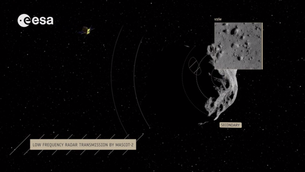 |
| Space in Images - 2015 - 09 - AIM Infographic - general |
As part of ESA’s proposed Asteroid Impact Mission would come the Agency’s next landing on a small body since Rosetta’s Philae lander reached 67P/Churyumov–Gerasimenko in 2014.
In 2022 the Mascot-2 microlander would be deployed from the main AIM spacecraft to touch down on the approximately 170-m diameter ‘Didymoon’, in orbit around the larger 700-m diameter Didymos asteroid.
The 15 kg Mobile Asteroid Surface Scout-2 (Mascot-2) is building on the heritage of DLR’s Mascot-1 already flying on Japan’s Hayabusa-2. Launched in 2014, the latter will land on asteroid Ryugu in 2018.
Mascot-2 would be deployed from AIM at about 5 cm/s, and remain in contact with its mothership as it falls through a new inter-satellite communications system. Didymoon’s gravity levels will only be a few thousandths of Earth’s, so the landing would be relatively gentle, although multiple bounces may take place before it comes to rest.
Light-emitting diodes (LEDs) would help AIM to pinpoint its microlander’s resting place from orbit. In case of a landing in a non-illuminated area, a spring-like ‘mobility mechanism’ would let the microlander jump to another location. Onboard GNC ‘guidance navigation and control’ sensors would gather details of the landing both for scientific reasons and to determine the microlander’s orientation for deployment of the solar array to keep it supplied with sufficient power for several weeks of surface operations.
As well as a solar array, AIM would also deploy its low frequency radar LFR instrument, while cameras perform visible and thermal surface imaging. LFR would send radar signals right through the body, to be detected by AIM on Didymoon’s far side, to provide detailed subsurface soundings of an asteroid’s internal structure for the first time ever.
Radar Instruments:
High Frequency Radar (HFR)
The main objective of AIM’s monostatic High-Frequency Radar (HFR) is to
obtain information on the structure of the asteroid´s outermost surface
and sub-surface layers, up to a depth of 10 m with a resolution of
maximum 1 m (goal would be 0.2 m). Scanning Didymoon with an HFR
instrument would enable the scientists to study the layering of the
sub-surface and the 2D distribution of “rocks” on the surface.
Moreover, the HFR might be used to estimate the dielectric permittivity of the sub-surface material to gain insight into the surface composition and the content of volatile compounds. It may also provide valuable data on dust particles around Didymoon (before and after impact) and may be used to support the visual data on Didymoon’s mass and shape.
Moreover, the HFR might be used to estimate the dielectric permittivity of the sub-surface material to gain insight into the surface composition and the content of volatile compounds. It may also provide valuable data on dust particles around Didymoon (before and after impact) and may be used to support the visual data on Didymoon’s mass and shape.
Low Frequency Radar (LFR)
Low-frequency radar scanning between lander and AIM spacecraft
 The AIM bistatic Low-Frequency Radar (LFR) main goal is to obtain data
on the asteroid internal structure, with a typical resolution of 30
meters. Both the main AIM spacecraft and the lander will carry an
emitter and receiver of the LFR so that signals can be sent through
Didymoon during full asteroid rotations. During these measurements the
geometry will change from the lander facing the main spacecraft to the
lander and the main spacecraft being on opposite sides of the asteroid.
The AIM bistatic Low-Frequency Radar (LFR) main goal is to obtain data
on the asteroid internal structure, with a typical resolution of 30
meters. Both the main AIM spacecraft and the lander will carry an
emitter and receiver of the LFR so that signals can be sent through
Didymoon during full asteroid rotations. During these measurements the
geometry will change from the lander facing the main spacecraft to the
lander and the main spacecraft being on opposite sides of the asteroid.
These full asteroid rotation measurements will enable a full characterisation of the homogeneity of Didymoon and extensive study of the mineralogy and porosity of the internal structure. Variations in density and a complete mapping of Didymoon’s 3D structure (and deep layering) will also become apparent.

No comments:
Post a Comment